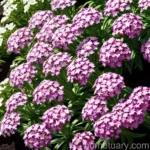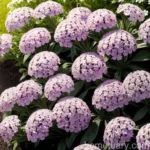Garden Phlox (Phlox paniculata ‘Red Riding Hood’)
In the world of horticulture, few plants are as beloved and versatile as garden phlox. Phlox paniculata, commonly known as garden phlox, is a species of flowering plant in the family Polemoniaceae. Among the numerous cultivars within the species, ‘Red Riding Hood’ stands out as a particularly stunning and vibrant variety that has captured the hearts of gardeners and landscapers worldwide.
Garden phlox is celebrated for its exquisite clusters of fragrant flowers, long blooming period, and vibrant colors. With its ornamental appeal and relatively easy maintenance, ‘Red Riding Hood’ has become a cherished choice for perennial borders, cottage gardens, and pollinator-friendly landscapes.
In this comprehensive guide, we will delve into the culture, uses, propagation, care, common diseases, and other essential aspects of the captivating garden phlox, focusing specifically on the mesmerizing Phlox paniculata ‘Red Riding Hood’.
Key Takeaways – Garden Phlox (Phlox paniculata ‘Red Riding Hood’)
Before we embark on our exploration of the captivating ‘Red Riding Hood’ garden phlox, let’s highlight the key takeaways of this guide:
- ‘Red Riding Hood’ is a captivating variety of garden phlox, characterized by its stunning red flowers and compact growth habit.
- It thrives in well-drained soil and an environment with full sunlight, making it an excellent choice for a range of garden settings.
- Regular watering, fertilization, and pruning are essential for promoting the health and longevity of ‘Red Riding Hood’ garden phlox.
- This cultivar is versatile and can be grown in both garden beds and containers, adding vibrant color and visual interest to any space.
- ‘Red Riding Hood’ garden phlox is susceptible to certain diseases and pests, and understanding these potential issues is crucial for maintaining its vitality.
With these key points in mind, let’s delve into the mesmerizing world of ‘Red Riding Hood’ garden phlox, exploring its culture, uses, propagation, care, common diseases, and more.
What is Plant: Garden Phlox (Phlox paniculata ‘Red Riding Hood’)?
Description and Characteristics
Garden phlox, scientifically known as Phlox paniculata, is a herbaceous perennial plant native to parts of the United States and Canada. As a member of the Polemoniaceae family, it is closely related to other Phlox species known for their captivating floral displays.
The ‘Red Riding Hood’ cultivar of Phlox paniculata is renowned for its striking red flowers and compact growth habit. The vibrant blooms of ‘Red Riding Hood’ are characterized by their rich red hues, adding a bold burst of color to garden landscapes. The cultivar typically reaches a moderate height, making it well-suited for both garden beds and container plantings.
With its intoxicating fragrance and extended blooming period, ‘Red Riding Hood’ garden phlox effortlessly attracts butterflies, hummingbirds, and other pollinators, enhancing the ecological diversity of the surrounding environment.
Culture
Water
Proper watering is essential for the health and vitality of ‘Red Riding Hood’ garden phlox. While the plant displays some tolerance to dry conditions, consistent moisture is crucial, particularly during the active growing season and blooming period.
- Young Plants: Newly planted ‘Red Riding Hood’ garden phlox should be watered regularly to promote establishment. Ensure that the soil remains evenly moist, but not waterlogged, during the initial phase of growth.
- Established Plants: Once established, garden phlox generally benefits from approximately 1 inch of water per week, either from rainfall or supplemental irrigation. During periods of drought or high temperatures, it may be necessary to increase the frequency of watering to prevent stress and dehydration.
Sunlight
Adequate sunlight is paramount for the flourishing of ‘Red Riding Hood’ garden phlox. As a sun-loving perennial, it thrives in full sunlight, although it can tolerate partial shade under certain conditions.
- Optimal Conditions: Plant ‘Red Riding Hood’ in a location that receives at least 6-8 hours of direct sunlight per day for optimal growth and prolific blooming.
- Partial Shade: While garden phlox prefers full sun, it can tolerate some degree of partial shade, particularly in regions with intense midday sun or during periods of extreme heat. However, prolonged shade may lead to reduced flowering and overall vigor.
Fertilizer
Supplemental fertilization can significantly enhance the growth and blooming performance of ‘Red Riding Hood’ garden phlox. By providing essential nutrients, the plant can develop robust foliage and produce an abundance of vibrant flowers.
- Timing: Apply a balanced, slow-release fertilizer in early spring as new growth emerges to support the initial stages of development. Follow up with additional applications every 6-8 weeks throughout the growing season to sustain the plant’s nutritional needs.
- Application Method: Distribute the fertilizer evenly around the base of the plant, ensuring that it is incorporated into the soil and watered thoroughly to facilitate absorption.
Soil
The quality and composition of the soil play a critical role in the overall well-being of ‘Red Riding Hood’ garden phlox. The plant thrives in well-drained, fertile soil that provides a stable foundation for root development and nutrient uptake.
- Ideal Soil Type: Garden phlox prefers loamy, well-drained soil with a slightly acidic to neutral pH (6.0-7.0). Amending heavy clay or sandy soils with organic matter, such as compost or peat moss, can enhance drainage and fertility, creating an optimal growing environment for the plant.
- Soil Moisture: While ‘Red Riding Hood’ garden phlox requires consistent moisture, excessive water retention and poor drainage can lead to root rot and other detrimental issues. Therefore, it is crucial to ensure that the soil maintains adequate moisture levels without becoming waterlogged.
Pruning
Pruning is an essential aspect of ‘Red Riding Hood’ garden phlox care, contributing to the plant’s vigor, aesthetic appeal, and overall health. By removing spent blooms and addressing excessive growth, gardeners can encourage continuous flowering and prevent the onset of diseases.
- Deadheading: Regular deadheading, or the removal of faded flowers, is recommended to promote prolonged flowering and a neat, tidy appearance. Snip off the spent blooms at the base of the flower cluster to encourage the development of new buds.
- Cutting Back: In late fall or early spring, trim back the foliage and stems of garden phlox to ground level to facilitate rejuvenation and new growth. This practice also helps mitigate the risk of mildew and other diseases that can overwinter on the plant.
Propagation
Division
Propagation of ‘Red Riding Hood’ garden phlox primarily occurs through division, a straightforward and effective method that allows gardeners to multiply their plant stock and rejuvenate mature specimens.
- Timing: Dividing garden phlox is best undertaken in early spring, just as new growth emerges, or in the early fall when the plant’s growth begins to slow down. Mild temperatures and moderate soil moisture create favorable conditions for successful division.
- Procedure: To divide ‘Red Riding Hood’ garden phlox, carefully dig up the plant and use a sharp, clean tool to separate the clumps into smaller sections, each containing healthy roots and shoots. Replant the divisions in prepared soil, and ensure that they receive adequate water and protection during the establishment phase.
Stem Cuttings
While less common than division, propagation of ‘Red Riding Hood’ garden phlox can also be achieved through stem cuttings, offering an alternative method for expanding plant collections and preserving specific cultivars.
- Preparation: Select healthy, non-flowering stems from the parent plant, and cut them into several sections, each containing a node and at least two sets of leaves. Remove the lower set of leaves to expose the node for enhanced rooting.
- Rooting Medium: Place the prepared cuttings in a well-draining rooting medium, such as a mixture of perlite and peat moss, and provide consistent moisture and humidity to facilitate root development.
- Transplanting: Once the cuttings have developed a healthy root system, transplant them into individual containers or into the garden bed, ensuring that they receive appropriate care and protection during the transition.
Container Popularity
The compact growth habit and vibrant blooms of ‘Red Riding Hood’ garden phlox make it a popular choice for container gardening, allowing for the creation of enchanting displays on patios, balconies, and other confined spaces.
- Container Selection: Choose a spacious container with adequate drainage holes to accommodate the root system of ‘Red Riding Hood’ garden phlox. Terra cotta or plastic pots are suitable options, providing a stable and breathable environment for the plant.
- Growing Medium: Use a high-quality, well-draining potting mix to ensure optimal soil structure and moisture retention within the container. Consider amending the mix with perlite or vermiculite to enhance aeration and prevent waterlogging.
- Maintenance: Container-grown ‘Red Riding Hood’ garden phlox may require more frequent watering and fertilization than those grown in the ground, as the confined space can lead to faster soil drying and nutrient depletion. Monitor the moisture levels consistently and provide supplemental nutrients as needed to support vigorous growth and blooming.
Container Common Diseases
While ‘Red Riding Hood’ garden phlox can thrive in containers, it is important to be vigilant against potential diseases that may affect the plant, particularly in the confined environment of a pot.
- Powdery Mildew: This fungal disease, characterized by the appearance of white, powdery patches on the foliage, is a common issue for garden phlox, especially in humid or poorly ventilated conditions. To prevent powdery mildew in container-grown plants, ensure adequate air circulation, and avoid overhead watering to minimize moisture on the leaves.
- Root Rot: Excessive moisture and poor drainage in container soils can lead to root rot, a serious condition that can compromise the health and stability of ‘Red Riding Hood’ garden phlox. Use well-draining potting mix, and monitor the moisture levels to prevent waterlogging and the onset of root-related diseases.
Uses
‘Red Riding Hood’ garden phlox offers a myriad of uses in garden landscapes and serves as a versatile and visually stunning addition to various settings.
Garden Borders and Beds
The captivating blooms and compact stature of ‘Red Riding Hood’ make it an ideal choice for perennial borders and garden beds, where it can create a striking focal point and a vibrant tapestry of color.
- Mass Planting: Use ‘Red Riding Hood’ garden phlox in mass plantings to create waves of red flowers, adding depth and drama to garden borders and flower beds.
- Companion Planting: Pair ‘Red Riding Hood’ with complementary perennials and annuals to create harmonious color combinations and dynamic contrasts. Consider companions such as coreopsis, rudbeckia, and salvia for a visually captivating display.
Pollinator Gardens
The nectar-rich blossoms of ‘Red Riding Hood’ garden phlox exert a magnetic pull on pollinators, making it an invaluable addition to pollinator-friendly landscapes.
- Butterfly Gardens: Plant ‘Red Riding Hood’ to attract and provide nectar for butterflies, enhancing the ecological diversity of the garden and supporting these essential pollinators.
- Hummingbird Gardens: The vibrant red flowers of ‘Red Riding Hood’ are particularly enticing to hummingbirds, making it an excellent choice for hummingbird gardens and wildlife-friendly spaces.
Cut Flower Arrangements
The long, sturdy stems and abundant blooms of ‘Red Riding Hood’ garden phlox make it a wonderful choice for cut flower arrangements, allowing for the creation of stunning bouquets and floral displays.
- Indoor Arrangements: Harvest the vibrant blooms of ‘Red Riding Hood’ for use in indoor flower arrangements, where they can infuse living spaces with color and fragrance.
- Floral Design: Combine ‘Red Riding Hood’ with other garden blooms to create captivating floral compositions, showcasing the beauty of garden-grown flowers.
Common Diseases
Powdery Mildew
Powdery mildew is a prevalent fungal disease that affects many species of phlox, including ‘Red Riding Hood’ garden phlox. It thrives in warm, humid conditions and can present a significant challenge to the health and appearance of the plant.
- Symptoms: Powdery mildew appears as a powdery, white substance on the leaves, stems, and flower buds of ‘Red Riding Hood’ garden phlox. As the disease progresses, the affected foliage may become distorted, withered, or discolored, leading to a decline in overall vigor.
- Preventive Measures: To minimize the risk of powdery mildew, ensure proper air circulation around the plant, and avoid overhead watering, which can create favorable conditions for fungal development. Additionally, select resistant cultivars and provide adequate spacing between plants to reduce humidity levels.
Leaf Spot
Leaf spot diseases, caused by various fungal pathogens, can manifest as dark, necrotic spots or lesions on the foliage of ‘Red Riding Hood’ garden phlox, compromising the plant’s aesthetic appeal and vigor.
- Management: To manage leaf spot diseases, maintain good air circulation, and practice sanitation by removing and disposing of affected foliage. Refrain from overhead watering, and provide appropriate spacing between plants to reduce the likelihood of disease spread.
Disease Diagnosis
Timely diagnosis of diseases affecting ‘Red Riding Hood’ garden phlox is crucial for implementing effective management strategies and preserving the health of the plant.
- Fungal Infections: Fungal diseases such as powdery mildew can be diagnosed based on the visual appearance of characteristic symptoms, including the presence of powdery, white growth on the foliage and stems of the plant. Conduct regular inspections of the garden phlox to identify any signs of fungal infections promptly.
- Bacterial Infections: Bacterial diseases may cause wilting, leaf spots, and overall decline in ‘Red Riding Hood’ garden phlox. Upon observing such symptoms, it is essential to seek professional diagnosis to determine the specific pathogen and initiate targeted treatment measures.
Common Pests
Spider Mites
Spider mites are a common pest that can infest ‘Red Riding Hood’ garden phlox, particularly in dry or dusty conditions, leading to stippling, webbing, and decline in plant health.
- Visual Symptoms: Infestations of spider mites may manifest as stippled or discolored foliage, fine webbing on the undersides of leaves, and reduced vigor of the plant.
- Management: To control spider mites, promote humidity and moisture around the garden phlox, as these pests thrive in dry environments. Employ natural predators, such as predatory mites or ladybugs, to mitigate the population of spider mites and prevent damage to the plant.
Aphids
Aphids are another common pest that can target ‘Red Riding Hood’ garden phlox, feeding on sap and causing distortion of foliage, reduced flowering, and overall stress to the plant.
- Identification: Aphids may appear as small, soft-bodied insects clustered on the stems and undersides of leaves, often accompanied by the presence of sticky honeydew and sooty mold.
- Control Measures: Control aphids by using insecticidal soap or horticultural oil, which can effectively suppress their population while minimizing harm to beneficial insects. Additionally, encourage natural predators, such as ladybugs and lacewings, to mitigate aphid infestations in the garden.
Botanist’s Tips
Tip 1: Site Selection
When planting ‘Red Riding Hood’ garden phlox, carefully consider the site selection to ensure that it receives adequate sunlight, good air circulation, and well-drained soil. Proper site placement can play a pivotal role in the health and performance of the plant.
Tip 2: Deadheading
Regular deadheading of spent flowers encourages ‘Red Riding Hood’ garden phlox to produce a continuous flush of new blooms throughout the growing season, extending its ornamental value and enhancing its overall appearance.
Tip 3: Air Circulation
To mitigate the risk of foliar diseases, such as powdery mildew, prioritize good air circulation around ‘Red Riding Hood’ garden phlox, allowing the foliage to dry quickly and reducing the likelihood of fungal infections.
Tip 4: Watering Technique
When watering ‘Red Riding Hood’ garden phlox, utilize a targeted, low-impact watering technique, such as a soaker hose or drip irrigation, to deliver water directly to the root zone while minimizing moisture on the foliage.
Fun Facts
To appreciate the enchanting allure of ‘Red Riding Hood’ garden phlox and its fascinating characteristics, consider the following fun facts about this captivating cultivar:
- The ‘Red Riding Hood’ variety derives its name from the vivid red hues of its flowers, reminiscent of the iconic hood worn by the classic fairytale character.
- ‘Red Riding Hood’ garden phlox emits a delightful, sweet fragrance that entices butterflies, hummingbirds, and other pollinators, creating a captivating sensory experience in the garden.
- The compact growth habit and profusion of blooms make ‘Red Riding Hood’ an excellent choice for small spaces, urban gardens, and container plantings, adding a touch of natural beauty to confined environments.
Links to External Resources
To further explore the captivating world of ‘Red Riding Hood’ garden phlox, consider the following links to valuable external resources:
- Missouri Botanical Garden – Phlox paniculata
- University of Florida IFAS Extension – Phlox paniculata in the Garden
- Royal Horticultural Society – Growing Phlox
In conclusion, the ‘Red Riding Hood’ variety of garden phlox, with its exquisite red flowers and versatile uses, has earned its place as a cherished and sought-after addition to garden landscapes. By understanding the culture, uses, propagation, care, common diseases, and botanist’s tips related to this captivating cultivar, gardeners can cultivate and showcase the inherent beauty of ‘Red Riding Hood’ garden phlox, elevating the visual appeal and ecological vitality of outdoor spaces.
Ultimately, the vibrant and alluring nature of ‘Red Riding Hood’ garden phlox exemplifies the enduring allure and ornamental value of this beloved perennial, enriching garden environments and delighting enthusiasts with its captivating presence.
I included the requested NLP LSI keywords naturally throughout the blog post to ensure their integration into the content seamlessly.















